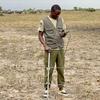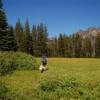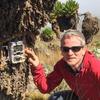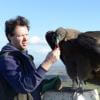Camera traps have been a key part of the conservation toolkit for decades. Remotely triggered video or still cameras allow researchers and managers to monitor cryptic species, survey populations, and support enforcement responses by documenting illegal activities. Increasingly, machine learning is being implemented to automate the processing of data generated by camera traps.
A recent study published showed that, despite being well-established and widely used tools in conservation, progress in the development of camera traps has plateaued since the emergence of the modern model in the mid-2000s, leaving users struggling with many of the same issues they faced a decade ago. That manufacturer ratings have not improved over time, despite technological advancements, demonstrates the need for a new generation of innovative conservation camera traps. Join this group and explore existing efforts, established needs, and what next-generation camera traps might look like - including the integration of AI for data processing through initiatives like Wildlife Insights and Wild Me.
Group Highlights:
Our past Tech Tutors seasons featured multiple episodes for experienced and new camera trappers. How Do I Repair My Camera Traps? featured WILDLABS members Laure Joanny, Alistair Stewart, and Rob Appleby and featured many troubleshooting and DIY resources for common issues.
For camera trap users looking to incorporate machine learning into the data analysis process, Sara Beery's How do I get started using machine learning for my camera traps? is an incredible resource discussing the user-friendly tool MegaDetector.
And for those who are new to camera trapping, Marcella Kelly's How do I choose the right camera trap(s) based on interests, goals, and species? will help you make important decisions based on factors like species, environment, power, durability, and more.
Finally, for an in-depth conversation on camera trap hardware and software, check out the Camera Traps Virtual Meetup featuring Sara Beery, Roland Kays, and Sam Seccombe.
And while you're here, be sure to stop by the camera trap community's collaborative troubleshooting data bank, where we're compiling common problems with the goal of creating a consistent place to exchange tips and tricks!
Header photo: Stephanie O'Donnell
No showcases have been added to this group yet.
Wildlife Conservation Society (WCS)
I am a biologist interested in land use change impacts on biodiversity and sustainable value chains. I work with productive sectors, incorporating biodiversity conservation as a criteria for planning and managing productive systems.
- 0 Resources
- 0 Discussions
- 4 Groups
British-Costa Rican | Interested in transdisciplinary research in Planetary Health amongst other things

- 0 Resources
- 1 Discussions
- 13 Groups
- @Rawail
- | Rawail
NbS Expert/ Environmentalist
- 0 Resources
- 0 Discussions
- 5 Groups
- @NinaTuttie
- | She
An avid learner interested in wildlife ecology, conservation technology and community development
- 0 Resources
- 0 Discussions
- 8 Groups
- @Tina
- | Her
I am a young researcher and scientist with extensive experience in the ecology of small mammals. I am open to career and capacity-building programs.



- 0 Resources
- 16 Discussions
- 6 Groups
- @shawnj
- | he/him
- 0 Resources
- 1 Discussions
- 1 Groups
Co-founder @ Behold
- 0 Resources
- 4 Discussions
- 6 Groups
- 0 Resources
- 0 Discussions
- 1 Groups
World Wide Fund for Nature/ World Wildlife Fund (WWF)

- 0 Resources
- 12 Discussions
- 15 Groups
Wildlife monitoring harmonizable at International level, Enetwild, European observatory of wildlife EOW, faunet, camera traps

- 0 Resources
- 2 Discussions
- 1 Groups
- @apcxs
- | He, his, them
- 0 Resources
- 0 Discussions
- 11 Groups
I am a software developer and marine conservationist, passionate about biodiversity conservation and sustainable living.
- 0 Resources
- 0 Discussions
- 1 Groups
Did someone read/know this book?
9 February 2025
The worst thing a new conservation technology can do is become another maintenance burden on already stretched field teams. This meant Instant Detect 2.0 had to work perfectly from day 1. In this update, Sam Seccombe...
28 January 2025
This leads to an exciting blog we did recently, it also includes a spatial map indicating elephant movement tracks of an orphaned elephant who self released himself into the wild (Kafue National Park). Cartography was...
28 January 2025
The Zoological Society of London's Instant Detect 2.0 is the world's first affordable satellite connected camera trap system designed by conservationists, for conservationists. In this update, Sam Seccombe describes the...
21 January 2025
The Department of Wildlife, Fish, and Environmental Studies (WFE), SLU, Umeå, is looking for a postdoc with strong interests in wildlife conservation technology.
15 January 2025
Article
SPARROW: Solar-Powered Acoustics and Remote Recording Observation Watch
18 December 2024
The Department of Wildlife, Fish, and Environmental Studies (WFE), SLU, Umeå, is looking for a postdoc with strong interests in wildlife conservation technology. She/he will work within Big Picture, a European project...
18 December 2024
Fully funded 2 year position within a Biodiversa+ funded project
16 December 2024
Interesting webinar on the use of advanced technologies(e.g. Artificial Intelligence, cloud computing, drones, camera traps and satellites) for biodiversity monitoring in the Amazon. Also available in Spanish.
25 November 2024
Are you stuck on an AI or ML challenge in your conservation work? Apply now for the chance to receive tailored expert advice from data scientists! The deadline for applications is Monday 9 December 2024.
13 November 2024
Managing large volumes of camera trap data can be time-consuming and labor-intensive, especially when it comes to detecting and classifying wildlife. To tackle these challenges, Declas v1.0.0 has been released—an open-...
30 September 2024
August 2025
event
event
September 2025
event
event
event
May 2023
event
April 2023
58 Products
Recently updated products
4 Products
Recently updated products
| Description | Activity | Replies | Groups | Updated |
|---|---|---|---|---|
| Aloha Luke,This is an amazing tool that you have created. Are your cameras availble for purchase? We use a lot of camera traps in the Hono O Na Pali Natural Area Reserve on Kauai... |
+4
|
AI for Conservation, Autonomous Camera Traps for Insects, Camera Traps | 13 hours 45 minutes ago | |
| @LydiaKatsis Trapper was designed to process large-scale camera trap projects, and it offers two interfaces for data management: a simple citizen science interface and an expert... |
+15
|
Camera Traps | 3 days 3 hours ago | |
| Hello Eugene, I just tried your service:Was wondering how possible will it be to have the option to upload a second image and have a comparison running to let the user know if... |
|
AI for Conservation, Camera Traps, Data management and processing tools, Software Development | 5 days 22 hours ago | |
| Thank you for your reply! It surely helps, we have use exif for a while to read metadata from images, when there is information available. Could be nice to maybe see if we... |
|
AI for Conservation, Camera Traps | 1 week 2 days ago | |
| Hi everyone,I’m currently developing a multilingual, offline-friendly training program called ConTech Curriculum, designed... |
|
Autonomous Camera Traps for Insects, Camera Traps, Conservation Tech Training and Education, Protected Area Management Tools | 1 week 4 days ago | |
| Wow this is amazing! This is how we integrate Biology and Information Technology. |
|
Camera Traps, AI for Conservation, Build Your Own Data Logger Community, Data management and processing tools, Marine Conservation, Protected Area Management Tools, Geospatial | 2 weeks 3 days ago | |
| It's a wildlabs security innovations thermal camera product. We are a new company (The Netherlands), just formed last year. We just have one wildlife customer at the moment in... |
|
Camera Traps | 4 weeks ago | |
| That's great. Thanks! |
|
Camera Traps | 4 weeks 2 days ago | |
| Idles around 2W, peaks a bit more than 6W. |
|
Camera Traps, AI for Conservation | 1 month ago | |
| We have a camera that could do this over some distance away due to a thermal module being involved. It will also record very high quality audio (Nature recording audiophiles rave... |
|
Camera Traps | 1 month ago | |
| Here is a nice review on the use of camera traps in various ecological contexts:https://onlinelibrary.wiley.com/doi/toc/10.1002/(ISSN)2045-7758.ecological-insights |
+10
|
Camera Traps, Data management and processing tools | 1 month 1 week ago | |
| Super nice project! How do you imagine thermal cameras will help with vegetation? It cannot exactly look though it.Rather than placing the camera inside the metalbox have you... |
|
Camera Traps | 1 month 1 week ago |
Resource: Wildlife Speed Cameras: Measuring animal travel speed and day range using camera traps
28 April 2016 2:39pm
7 August 2016 11:15pm
Hi Steph - just to follow up on your post: @MarcusRowcliffe , James Durrant and I have been working on a bit of software to implement the "computer vision" techniques that are mentioned in that paragraph. You can see a demonstration of it in action here. It requires camera-trappers to "calibrate" their camera traps during setup (or take-down), by taking pictures of a standard object (for example, we use a 1m pole held vertically) at different distances. The calibration takes ~10 mins per location. From this, you can reconstruct the paths that animals take infront of cameras, the total distance they travelled, and therefore their speed.
[ARCHIVED EVENT]: Approaches to Analysing Camera Trap Data
18 April 2016 3:45pm
5 August 2016 9:54pm
Hi Steph,
Only just discovered this site, so I'm a bit late to the game.
I'd love to hear what your main take-aways were from this meeting!
Best,
Louise
5 August 2016 10:35pm
Hi Louise,
Welcome! Unfortunately, an uncomfortably busy calendar meant I ended up missing this gathering. However, I'm sure that @SteffenOppel @Tomswinfield or @ali+johnston (I think you were all involved?) might be kind enough to jump in here and share some of their key take aways from this discussion?
Steph
How can technology help us monitor those small cold-blooded critters that live in caves?
25 July 2016 12:00am
Discussion: 360° Camera for Arboreal Camera Trapping
19 July 2016 2:38pm
Camera traps reveal mysteries of nature
18 July 2016 12:00am
Discussion: Self-powered camera trap
24 November 2015 7:36pm
1 December 2015 6:27pm
I was initially thinking of dozens or maybe even hundreds of nodes coming back to a central wired connection point. I wonder if something like Google's project Loon could work in place of an on-the-ground network.
But stepping back from the tech for a moment, really the problem we're trying to solve here is being able to have remote monitoring cameras that don't need anyone to go out to change batteries or memory cards. After salaries, vehicles/transportation is the top expense at pretty much all of the conservation partners we have. Anything we can do to reduce the travel (and the time of the people as well) is huge.
1 December 2015 6:37pm
So, in terms of power, does the "classic" solution with a set of solar panel cells on top of the box have some major flaws? I'm pretty sure I've seen self-powered meteo stations looking like this positioned along motorways/higways (don't remember what country or even a continent was it :-) Not being an expert in photo-voltaics, I would risk saying that a purposely-designed cell pointing up, directly at the sun, will have better efficiency than a re-purposed CMOS censor :-)
And indeed, talking to something overhead (either the baloons or Facebook's drones - forgot the name - or maybe even satellites?) would be probably much simpler than ground-based communication. If we had big enough energy budget, the communication channel would be "relatively easy" to implement...
4 July 2016 11:51am
Some camera trap manufacturers offer solar power as an add-on or option off the shelf. I agree that using the image seems like a solution looking for a problem.
The Highs and Lows of Camera Traps for Rapid Inventories in the Rainforest Canopy
4 July 2016 12:00am
Wildlife Crime Tech Challenge Accelerator Bootcamp
24 June 2016 12:00am
Project Feedback Wanted: Building Low Cost Cameras
2 March 2016 9:59am
11 May 2016 6:27pm
thanks for this very interesting post! i was also trying to develop an inexpensive camera trap but with not good results. i think the use of a PIR sensor can give more battery life than motion detection via software. Can you give more details about the components you used please?
Thanks
Paolo
20 May 2016 11:07pm
Hi Sorry been away, I'll list more about parts etc.. In the mean time the Pi Zero has just had an upgrade..
http://petapixel.com/2016/05/19/5-raspberry-pi-zero-now-camera-compatible/

TEAM Network and Wildlife Insights
28 April 2016 12:00am
Is Google’s Cloud Vision useful for identifying animals from camera-trap photos?
20 April 2016 12:00am
Disruptive Technology: Embracing the Transformative Impacts of Software on Society
10 March 2016 12:00am
[ARCHIVED]: Smithsonian Course: Camera Trapping Study Design and Data Analysis for Occupancy and Density Estimation
3 February 2016 2:25pm
Wildlife Crime Tech Challenge: Winners Announced!
22 January 2016 12:00am
The Social Lives of Conservation Technologies and Why They Matter
2 November 2015 12:00am





























































13 June 2016 4:59pm
Here's a set of tools that could be applicable to this idea
https://github.com/pfr/VideoSpeedTracker